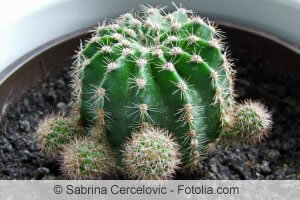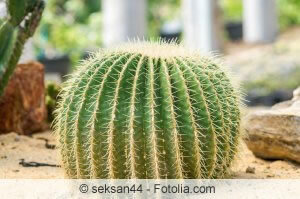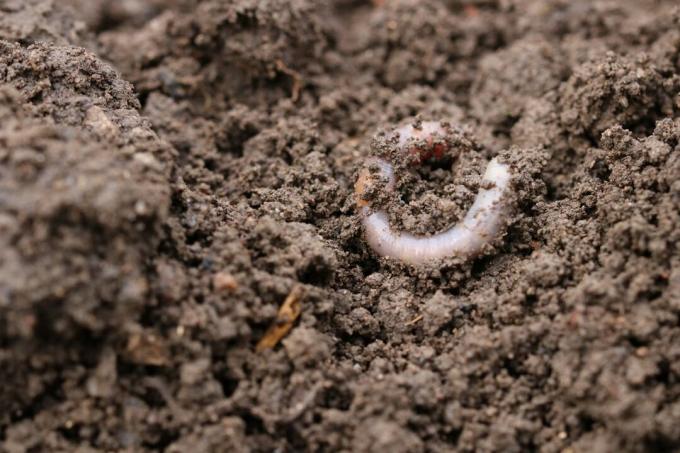

Table of contents
- Cactus substrates - less is more!
- Unsuitable substrates
- aggregates
- Optimal mix
- frequently asked Questions
Cacti and succulents are very undemanding plants, which influences the selection of a substrate. Mineral and low-humus soils are preferred, but there are many possible variations in their composition. You can also mix mineral substrates yourself to create optimal breeding ground for the cacti and succulents in which they can develop well.
Cacti and succulents are those plants that can bring a lot of joy even to people without a green thumb. Anyone who has already dealt more closely with cacti will quickly realize that they already inhabit the most impassable and infertile areas in their countries of origin. In this country, the cacti and succulents make similarly low demands and also need a little nutrient-rich soil. The ideal substrate for cacti therefore consists largely of mineral components. When selecting the individual mineral components, however, there are many possibilities for variation, which means that individual substrates can be mixed for cacti and succulents.
Cactus substrates - less is more!
There are around 1800 different types of cacti worldwide and there are also several thousand different types of succulents. Despite the different species, there is one thing these plants have in common - their preference for locations characterized by poor soil. The substrate should be constructed accordingly, which should be slightly acidic for most cacti. A pH value between 5.5 and a maximum of 7 would be ideal. It is important for the substrate that it has high air and water permeability. As in nature, where cacti and succulents grow on stony and gravelly soil, there is no waterlogging and excess nutrients can drain off. This is also important for growing in pots, as the cacti and succulents immediately after fertilization, the usually happens in liquid form, and superfluous nutrients would then lead to over-fertilization to lead.
Unsuitable substrates

Potting soil from the trade is completely unsuitable for cacti and succulents, as it can lead to strong growth, but can also lead to rot. In addition, the substrate should not exceed a pH value of seven, otherwise the soil will be too acidic, which will kill the cacti in the long term. If you are not sure what the pH value of the soil is, you can get a test set from the pharmacy and determine the pH value yourself. Not every mineral is also suitable for cacti and under no circumstances should building sand be used. This is too calcareous and can lead to what is known as chlorosis. The formation of chlorophyll is inhibited, which in the long term leads to the death of the cacti and succulents.
Tip:
The substrate should be adjusted in relation to the lime content if the irrigation water is very calcareous. Here you should generally pay attention to a lime-poor substrate, since the cacti are supplied with lime via the irrigation water.
aggregates
The list of possible substrates is long, since all cacti and succulents prefer mineral and nutrient-poor substrates, however, native succulent species, for example, can tolerate a higher proportion of humus than, for example, succulents from Mexico.
lava grit
Lavagrus is a volcanic material that should have a grain size between three and seven millimeters. It has the property that it can store large amounts of water, which is then gradually released back to the plants.
pumice
Pumice gravel is also of volcanic origin and has a slightly acidic pH value. Only fine-grained components of the pumice should be used, since fine sand or Dust could unnecessarily compact the substrate.
bedrock
Primary rock consists of granite or gneiss and is slightly acidic. The advantage is that this material has a high proportion of nutrients such as potassium or iron, which are gradually released from the rock and the cacti and succulents are supplied with it.
expanded slate
Bläschierer is ideal for creating drainage at the bottom of the pot. It also provides stability while ensuring good air and water permeability.
Quartz sand/quartz gravel
quartz sand or Quartz gravel is used to loosen the substrate and can also be used to cover the surface.
kieselguhr
Diatomaceous earth has a pH of about 5.5 and gradually releases important nutrients for cacti and succulents. It is also very good at binding moisture, which prevents mold from forming.
In addition to these additives, there are other additives such as clay, perlite and many more that are added to the substrate. When selecting the additives, it is important that those substances are used that are also found in the home of the cacti and succulents.
Optimal mix

If you have little experience with cacti, you can take a ready-made soil from a specialist shop and mix it with additives. However, the proportion of cactus soil should not be more than 75% and the remaining 25% can be filled with pumice, for example, which can also store nutrients well. If you already have experience with the cultivation of cacti, you can also completely use the substrate yourself mix, which, for example, also contain a small proportion of humus that is at least three years old can. For sowing cacti and succulents, however, the proportion of humus should be slightly larger and take up around 1/3. The rest consists of finely sieved mineral substrate, which is mixed with the humus.
Tip:
The substrate of cacti and succulents that come from the wholesale trade is often not suitable for the plants in the long term. Therefore, the plants should be repotted quickly in a freshly mixed substrate so that, for example, waterlogging or subsequent rotting of the roots cannot occur.
frequently asked Questions
Before using the mineral substrate, it is well moistened and sterilized in the oven for 30 minutes at around 150 °C. This kills fungal spores, for example, which can damage the plants. A sterilized soil is particularly important when sowing, otherwise foreign seeds could germinate and unnecessarily take away nutrients from the cacti and succulents.
In any case, opinions differ here, because both have advantages and disadvantages. Clay pots support faster evaporation, but can break quickly and are expensive. Plastic pots are sturdier and cheaper, but require better drainage as evaporation is significantly slower.
 garden editorial
garden editorial I write about everything that interests me in my garden.
Learn more about floor care

Digging up the garden: 13 tips for lawns and beds
Whether it makes sense to dig up beds or lawns is discussed in different ways. Once you have decided on this measure, our tips will help you to organize work in the garden effectively.

Pine bark: suitable for which plants?
Pine bark is a type of mulch that is gaining popularity among many garden owners due to its color and properties. Before purchasing, the question often arises as to which plants the bark mulch is suitable for. This question is justified because of the origin of the pine.

Which soil to choose for elephant foot?
The right substrate is crucial for the elephant's foot and should therefore be chosen well. Read here which soil is best suited for the Beaucarnea recurvata!

Expanded clay as a water reservoir: The alternative to earth?
Expanded clay is known to many as a substrate for hydroponics or as drainage in pots. Due to its properties, the clay granulate is suitable as a substrate in many different areas and can replace soil. The granules have long been an indispensable basis for green roofs.

Potting soil: Mix the potting soil yourself
Potting soil has to meet special requirements. It can therefore often make sense to mix potting soil yourself. This comes with several advantages. But what do you have to pay attention to? The guide below shows how to do it.

pH value in the soil: 15 tips for measuring & regulating
If the pH of the garden/plant soil is suboptimal, this can lead to serious plant damage. We show what options there are for measuring and regulating.



